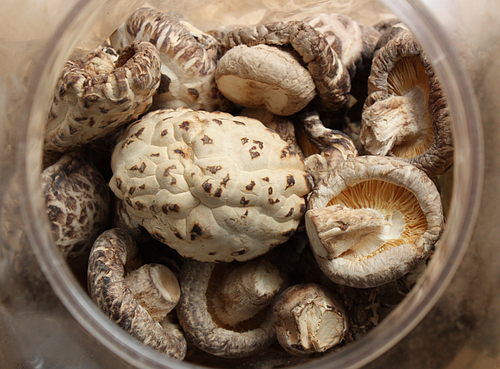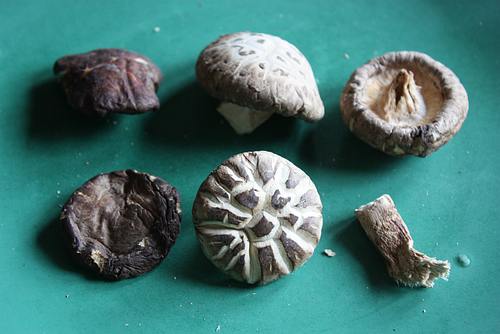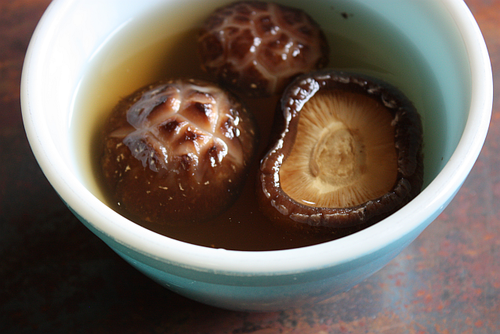
When I’m out of dried shiitake mushrooms, it’s practically a kitchen emergency. I use them all the time in East Asian cooking to amp up umami goodness, whether it’s in a stir-fry, soup, dumpling filling, or a tofu dish. In Vietnamese, they’re called nam dong co kho or nam huong kho by southern and northern Viet speakers, respectively. The mushrooms in dried form are most often used in my house so we drop the “kho” (dried) when we refer to them. Shiitake mushrooms are typically added during the cooking process. I’ve never eaten them raw. (Have you?)
I decided to write about dried shiitake mushrooms because people ask for tips on how to buy them and prep them. Frankly, the ones sold at mainstream supermarkets are sad, thin capped and mildly flavored. They’re also expensive. Feel free to add your pointers to mine below:
Where to buy dried shiitake mushroom
When you can, head to an Asian market or Chinese herbal shop. You’ll get the best selection and price. If there are special deals, chances are they’re displayed as end caps. But you’ll find a bigger variety in the aisle where dried vegetables and beans are shelved.
Study your options and consider buying a decent amount. After all, dried shiitake mushroom keep for a very long time (probably years but I use mine up fast). I usually purchase a one-pound package of good shiitakes for $15 to $20. Note that premium boxes of mushrooms make great gifts. Gift yourself or an avid cook.
Beware of cheap deals on packages with beautiful big ones displayed on top. More often than not, a bunch of scrawny mushrooms of lesser quality are hidden underneath voluptuous ones. (Guess I’m still somewhat bitter by that bait-and-switch package of shiitakes from years ago.)
What to look for in a good shiitake & how store
Select whole mushrooms, not presliced ones, which can be of questionable quality. Plus, it’s harder to gauge how much of the presliced dried mushroom is needed to equal a full cap. Most recipes call for a full-cap count of shiitake mushroom, not weight. Finally, you can’t control the size of your prepped mushroom. Convenience is not always a good thing.
Before buying, consider the mushroom cap thickness and check for fissures (see above). Thick mushrooms with deep white fissures on the caps tend to have the most flavor. They may be labeled hana, or “flower” mushroom, a term Japanese packagers use to signal the highest grade. Second-grade mushrooms are also thick but have fewer fissures. The downside to the thick-capped mushroom is that they take longer to rehydrate. You have to plan ahead, or take shortcut measures like the ones below.
Once home, I open the package and dump the dried shiitake mushrooms (along with the silica pack, if included) into a plastic container. I keep the container in the cupboard within easy reach because I use them often. Other cooks prefer to freeze their dried shiitakes. I suppose it depends on humidity where you live. Where do you stand?
How to prep dried shiitake mushrooms

Dried shiitakes require soaking before you can use them. One of the things I recently started doing is removing the stem beforehand. I snap them off with my fingers or hack them off with a cleaver. The stems can be used for stock later on. Just toss them back into your container.
The best method that I’ve found is a long soak in lots of water for 8 hours or overnight. Put the mushroom in a bowl, add water, and tumble the shiitake around to wet them. Then turn them so the absorbent gills point down. The water temperature doesn’t
matter. Follow this long soak method and the rehydrated mushrooms will be deeply
flavored, amazingly firm and velvety when cut. A long soak works wonders on cheapie dried shiitakes too!
Pressed for time? Hack or cut the mushroom cap in half and/or use hot water. The hot water rushes things and the flavor isn’t as elegant as a long soak. But, you get what you need fast.
Regardless of soaking method, before using your plumped up mushrooms, rinse out any particles of sand or dirt trapped under the gills, and give each a gentle squeeze to expel excess water. Reconstituted shiitake mushrooms can be refrigerated in a zip-top bag or airtight container for a week.
Save the shiitake soaking liquid?
The mushroom soaking liquid is particularly good if you need to boost umami in vegetarian dishes, like the roasted kabocha squash dumplings. Just today, I combined the soaking liquid with canned chicken broth to add extra flavor to a pot of chicken and shiitake mushroom rice. I tend to not use a bunch of the soaking liquid as is because it can overwhelm other ingredients and turn a dish into a damp forest floor. I’ve never stored the soaking liquid but I suppose you could do that for a future use.

Subbing fresh shiitake for dried ones & vice versa
I only do this when voluptuous, thick-capped fresh shiitake are available. The fresh ones at Chinese markets are super affordable but know that they often come from China. Knock on wood I’ve not had problems with those. But then, the dried shiitakes that I buy are from China.
Occasionally excellent domestically cultivated fresh shiitakes are sold at my local market. That’s when I strike. Otherwise, I walk right past the fresh shiitakes. Their creamy brown, thin caps don’t appeal. They’re just wimpy. If a recipe calls for fresh ones, like the udon with clams and shiitake (a Japanese take on Italian pasta with clams) or Korean shrimp dumplings, I’d sub rehydrated dried mushroom for the fresh adding a little extra moisture (soaking liquid or water) as needed to mimic the fresh mushroom texture and impact on the dish.
Shiitake mushroom are workhorses in many Asian kitchens. Invest in a supply of excellent ones and you won’t regret it.
Safimex company has supplying Dried shiitake mushroom in bulk with good prices. If you are interested in this product, please feel free to contact us at info@safimex.com or click at: https://www.alibaba.com/product-detail/Whole-Dried-Shiitake-Mushrooms-for-Soup_10000016404784.html?spm=a27gk.ggs-spa.0.0.55c3EMONEMONBo
Source: Vietworld kitchen
SAFIMEX JOINT STOCK COMPANY
Head Office: 216/20a Duong Ba Trac Street, Ward 2, District 8, Hochiminh City, Vietnam.
Tel: (+84)-(28)-3636 2388 | (+84)-(28)-3636 2399 | Website: https://safimex.com
